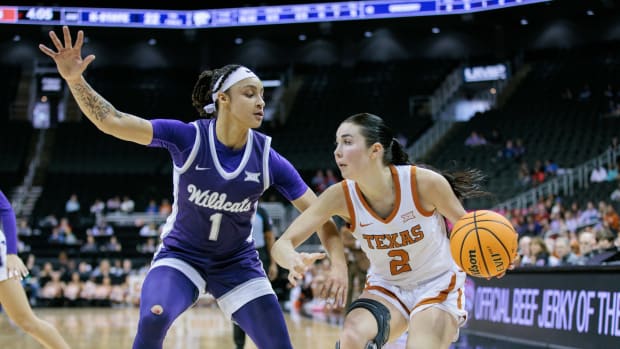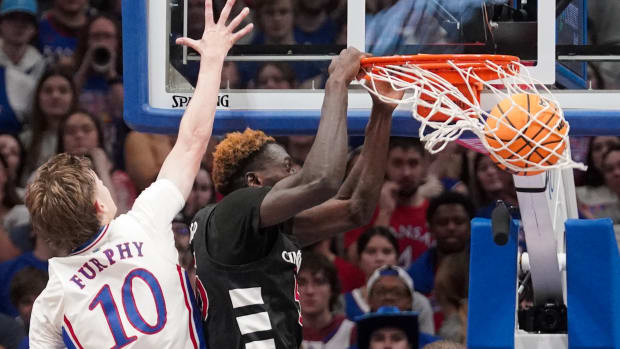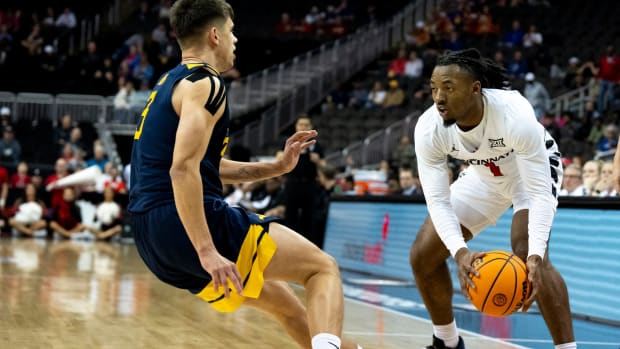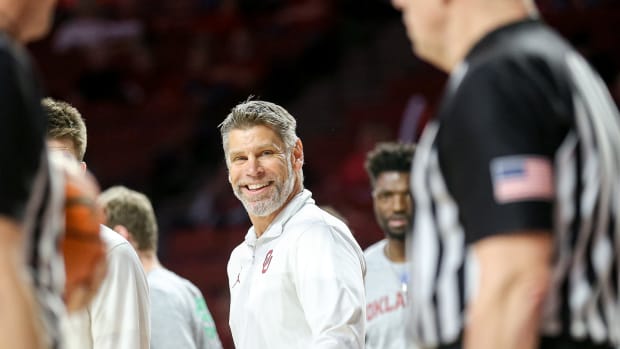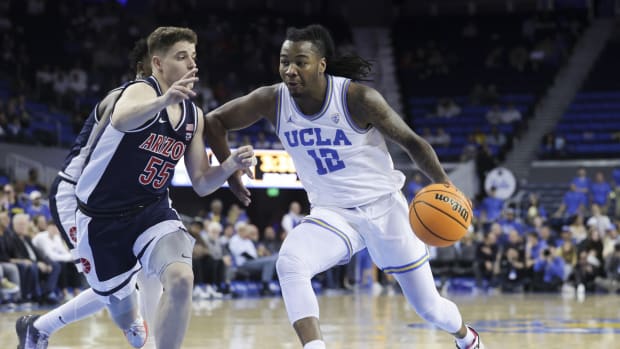Even without a title, Gonzaga's remarkable run forever alters the perception of its program
GLENDALE, Ariz.— They had walked through the forest in the middle of the night, and now they were lying on their backs, on a dock that extended out over the black water of Lake Pend Oreille, staring up at an Idaho starscape that made them feel like they were inside of a vast dome, lit by a million tiny, flickering bulbs. An uninterrupted silhouette of the conifer tree-line ringed the lake, and Gonzaga's players were all alone except for their fellow teammates. Eclectic rosters are kind of Gonzaga's thing, but these 17 guys comprised its most audacious mashup of talent yet—regular transfers and graduate transfers, fifth-year seniors and McDonald's All-America freshmen, West Coast Americans and European imports—and they needed to bond, quickly. And so on the second weekend of September, they drove an hour from their campus in Spokane to Idaho’s Farragut State Park for a two-day camping trip.
It was no ordinary outdoor experience. The trip was run by an Army Special Forces chaplain, Anthony Randall, and it was the brainchild of the Zags’ strength and conditioning coach, Travis Knight, and their team psychologist, Jon Hammermeister. And the Zags were no ordinary campers. Their coach, Mark Few, dropped in on them and found them to be “such wusses, out there in the woods,” that he worried: “How could they possibly be tough?” Or as Knight puts it, “Most of the guys who only own designer jeans were struggling.”
They were tasked with setting up their tents, sans instructions, and Washington transfer Nigel Williams-Goss and the returning sophomore he’d be sharing point-guard duties with, Josh Perkins, were flummoxed. Missouri transfer Johnathan Williams III, who grew up in Memphis, and freshman Zach Norvell Jr., from Chicago, had city-kid freakouts over what might be lurking in the forest. The Zags did rally, though, to complete challenges, including a slog in which they paired up to carry 60-pound sandbags on their shoulders, stopping at quarter-mile checkpoints where they developed themes for the upcoming season, and wrote those words on the sandbags in marker. Among them were sacrifice, unselfishness, love and connectedness.
Redemption: North Carolina creates new ending to familiar championship path
Their midnight “hike” to the lake had been an impromptu event on the first night, when no one could fall asleep. They began shouting at each other, from tent to tent, and eventually a plan was floated: put on your headlamps, and let's explore. “Some people were like, ‘This is not a good idea,’ but we dragged them along,” says Williams-Goss. By then the Zags had already set a goal of making it to Phoenix for the Final Four, but this team, despite needing to replace four starters and assimilate nine new players, started thinking even bigger out on that dock, under the stars.
“That was the first time,” Williams-Goss says, “that we started talking about a national title. Joking about it at first. Saying stuff like, ‘How many people would be waiting for us in Spokane when we got back?’ or ‘Would they have a parade?’ But it’s funny—to think back to that, because we were already saying, “Could you imagine what a national championship would be like?”
***
Could you imagine, that the dream of all those yet-to-be-connected Zags nearly came true? That with 1:52 left in the national championship game on Monday night, they led North Carolina, 65–63, and were closing in on the first championship by a team from outside the major conferences since UNLV in 1990? And that they were doing it not by subterfuge, but rather by proving that their defense, which came into the final ranked No. 1 in adjusted efficiency, was tough enough to cause problems for the high-powered offense of the third-winningest program in the history of college basketball?
"I asked this team to—this is why they're so frickin' amazing, I asked them to outrebound Carolina," says Few. "They outrebounded Carolina [49-46]. We asked them to drive their three percentages down, especially for [Justin] Jackson who came into the thing on fire, and for [Joel] Berry. They drove the three percentages down [to 14.6%]. So they did everything we asked them to do."
The Zags endured extreme foul trouble—in a flow-less, atrociously whistled game, freshman phenom center Zach Collins fouled out with 5:03 left, starting center Przemek Karnowski had four, and starting power forward Johnathan Williams III had four. As associate head coach Tommy Lloyd puts it, "We'd never had them all in foul trouble before." They also endured ice-cold, point-blank shooting in the post from Karnowski, who went 1-of-8 on twos—another thing that Lloyd says had never happened to Gonzaga.
• Get SI's North Carolina championship package
All the Zags needed to do was close. With 1:40 left, they gave up an and-one bucket to a cutting Jackson on a tightly-zipped pass by Theo Pinson, and fell behind 66–65. There was no question that they would turn to Williams-Goss, the junior they called their closer, and the point guard who'd long ago emerged as their leader after leaving a middling Pac-12 program in search of something bigger at Gonzaga. Williams-Goss's toughness in isolation, including a driving floater against Jackson with 2:24 left, and a post-up bank-shot over Pinson with 1:52 left, were what had put the Zags in the lead, and he had already scored a team-high 15 points.
Who knows if what happened next was the thing that kept a program from finishing one of the most meaningful title runs in the history of college hoops, but it was a stroke of bad luck at the worst possible time. With 1:27 on the clock, Williams-Goss re-sprained his right ankle—and "sprained it pretty good," he says—while making a off-ball cut on offense and being bumped by Pinson. It was the same ankle Williams-Goss had turned in the Zags's Final Four win over South Carolina, and it clearly hobbled him. Gonzaga called timeout at 1:25; Williams-Goss stayed in the game, coming out of the huddle hopping across the court, testing the ankle. Six seconds after the ball went live again, when he shot-faked against Theo Pinson and then launched a mid-range fadeaway, Williams-Goss's legs weren't under him, and it fell short. After the Zags got the ball back with 21.9 seconds left, down 68–65, they ran a high ballscreen for Williams-Goss. He drove near the right elbow but stumbled, due to his bum ankle, making a right-to-left spin move, and had no lift on a floater in the face of Carolina giant Kennedy Meeks. He smother-blocked the shot, starting a fastbreak that finished with a Jackson dunk and effectively ended Gonzaga's season. Soon after, the buzzer sounded on a 71–65 UNC win, and the streamers and confetti fell on the bluebloods. The 37-2 Zags were off the court and into their locker room well before One Shining Moment aired on the University of Phoenix Stadium videoboards.
Earlier on this trip to Arizona, the Zags had been able to soak up one, premature version of that famous highlight montage. On the Friday night before their 77–73, semifinal win over South Carolina, they gathered in a conference room at their hotel, The Westin Phoenix Downtown, to receive a final video scouting report on the Gamecocks. When the team finished watching film at approximately 10:20 p.m., the lights went up, and a back door of the conference room opened.
Surprise guests began filing in: former Gonzaga players, one after another, until there were nearly 50 in all. Among them was Matt Santangelo, the guard who helped lead the Cinderella run to the Elite Eight in 1999 that thrust the program into the national conscience; in 2017, he was the one who'd wrangled these ex-Zags together via group text. Blake Stepp, a backcourt star who ensured the program didn’t fade in the early 2000s, was there too. So was Ronny Turiaf, a product of Martinique and Gonzaga's first, high-impact import, and Adam Morrison, the nonconformist assassin whose cross-coastal battle with Duke’s J.J. Redick for the scoring title in 2005–06 captivated the country.
The idea was that the former Zags would express how proud they were of this team, the one that finally broke through to the Final Four. But the reverse occurred. "These are the O.G.s," Williams-Goss said, and he and grad-transfer guard Jordan Mathews instigated a team-wide standing ovation for the old players.
Catching up with Adam Morrison—Gonzaga's nonconformist star who captivated the nation
The message was that everyone in the room was part of what Morrison calls “this amazing, organic movement.” It’s crazy, he says, “that they could go from—and how do I say this P.C.—slow white guys to McDonald’s All-American type players.”
The lights went back down, and all of them—the slow white guys, the even slower white guys and the five-star recruits—watched a three-minute video that graduate assistant Ken Nakagawa had compiled. It was set to One Shining Moment, but it was all Zags: It showcased scenes from their 2017 tourney run interspersed with clips from their classic victories of the past. Their bid for the national title—even though it came up a few possessions short—was the culmination of a program’s unique and unimaginable rise out of the unknown.
***
To better understand how Gonzaga got here, it’s worth remembering that not so long ago, it was chasing perfection. As the Zags headed into their final regular-season game—against BYU at home on Feb. 25—they were 29–0, with a kenpom.com win probability estimate of 98.6% against the Cougars, and nearly 70% odds of finishing the WCC tournament unbeaten. Gonzaga was ranked No. 1 by every efficiency-based metric, and it was reasonable to wonder if it could become the first undefeated national champ since Indiana in 1975–76.
The BYU game was supposed to be a coronation. Commemorative 30–0 branded sections of the local paper, the Spokesman-Review, were pre-printed and in boxes at the arena, as were t-shirts celebrating the perfect regular season. The Cougars proceeded to pull off a seismic, 79-71 upset. The papers and t-shirts disappeared, and senior-night speeches for Karnowski, guard Mathews and walk-on Rem Bakamus were somber and abbreviated. “It was kind of a traumatic thing for the team,” says Lloyd. “We had it in the palm of our hands and let it slip away. It would have been better for them to lose game 26 than game 30.”
No one was more impacted by the BYU loss than Perkins, who committed two crucial turnovers in the final minute. “He was devastated, he lost some of his confidence, and we could see it in his body language,” Lloyd says. “But all these other issues finally came to the surface too. Everybody had been sacrificing all year for the greater good, and now it was being tested.”
There was the question of who should have the ball in endgame situations; the Zags had tried to make Williams-Goss their closer, but they’d been so dominant in WCC play that they hadn’t been in a game that needed closing since December. In practice and in the early part of the WCC tournament, Lloyd says he could see Williams-Goss getting more aggressive, “like a man on a mission”; meanwhile their talented centers, Karnowski and his McDonald’s All-American backup, Collins, were craving more post touches, and “suddenly, it was like we lost the rhythm of playing as a team. It was like everybody was on their own island, and we weren’t connected.”
North Carolina-Gonzaga was far from pretty, but Tar Heels a champion all the same
Gonzaga players noticed a general malaise too, and on their off-day at the WCC tournament in Las Vegas, following a win over ninth-place Pacific that featured an abysmal first half, Mathews called his teammates together for a meeting in the hotel room he shared with fellow transfer Jeremy Jones. “We just felt like something was off, and we wanted to hash it out,” Mathews says. In the 2016 off-season he’d completed six classes in 12 weeks at Cal so he could graduate and become immediately eligible at Gonzaga, with the goal of closing his career with a deep NCAA tournament run. Mathews told his teammates that he didn’t want to look back on this as a what-we-could’ve-done situation. “Let’s just do it now,” he said. The 7' 1" Karnowski, with his booming, Polish-accented voice, said he wanted to see a return of their midseason level of joy and emotion. “Let’s not,” he said, “get bored of winning.”
They did not see instant returns. The Zags let fourth-place Santa Clara hang around too long in a 77–68 semifinal win, but on March 7 they routed Saint Mary’s, for the third time this season, in the WCC championship, nudging themselves back toward powerhouse mode. And Knight, their strength-and-conditioning coach, had an idea to nudge them back even further. On the day before Selection Sunday he dragged some of the sandbags from the Zags’s September retreat—they’d been keeping them in a pile against one wall of their locker room—into an adjacent meal room, and brought the team in for a meditation session.
Knight had them lie on the floor and put their heads on the sandbags, as if they were pillows. He told them that things would get crazy soon, that these might be their last moments of peace, and their last chance to reset their minds. “Remember what we experienced that was so powerful, and why we’ve been able to stay together,” Knight told them. “It comes back to the idea of being connected to something bigger than yourself.” They were long out of the woods. But they were mindful of the words that were still legible on those sandbags—love and unselfishness—as they left to start the NCAA tournament in Salt Lake City.
***
In March 1995, the Zags deplaned in Salt Lake City and boarded a bus to what they expected would be a hotel. They had, after all, finally hit the big time; it was the program’s first trip to the NCAA tournament. But the bus pulled up, and … “It was not a hotel, it was a motel, where you drove your car up and put your headlights right into the window of your room,” says Few, who was then a 32-year-old assistant coach in his eighth season at Gonzaga. The motel was two stories, and its rooms all had outdoor entrances; as that team’s scoring leader, John Rillie, puts it, “It had the feeling of a holiday destination out of the ’60s.”
The Zags were a No. 14 seed that year, and they were naive about the workings of the tournament. It wasn’t until some of their players walked downtown, and noticed that their opponent, No. 3 Maryland, was in a nice Marriott tower, that “we realized the worse seed you were, the raggedier hotel you got,” says Kevin Williams, a guard on that team.
There was a hierarchy, and they were at the bottom. The NCAA was not going to pamper a No. 14 seed that, although it stayed in hotels while traveling during the regular season, otherwise operated on a low budget. Gonzaga's then-coach and athletic director, Dan Fitzgerald, would seek out cheap road eats for the team, the most infamous being a $5 special at a bowling alley in Los Angeles during their annual trip to Loyola Marymount and Pepperdine. Rather than receiving team gear to keep forever, players had to sign out their sweatsuits for the season and then sign them back in at the conclusion. And once the Zags broke through to the big dance in 1995, the NCAA seemed over-eager to check them out.
Georgetown's hiring of Patrick Ewing is a fascinating gamble
Few vividly recalls that, roughly eight hours before they were scheduled to tip off against the Terrapins, who were led by future NBA lottery pick Joe Smith, the NCAA phoned Fitzgerald to inform him what time the Zags’ charter flight back to Spokane would be departing that evening. Not if, but when. “It was like, assume the position,” Few says. “I guess they needed to be organized, play the odds… But I was saying, ‘You’ve gotta be kidding me.’ ”
The Zags were blown out by Maryland, 87–63, and sent home as scheduled. Most of the nation did not truly meet them until 1999, when Fitzgerald’s successor, Dan Monson, led them to the Elite Eight. After Monson left for Minnesota that off-season, Few took over as head coach, vowing that he did not want the Zags to be a one-hit wonder. They kept pumping out the hits, putting together a streak of 19 straight trips to the NCAA tournament, and when they deplaned in Salt Lake City in 2017, they were a No. 1 seed, put up downtown in the 4.5-star Hotel Monaco, while their No. 16-seeded opponent, South Dakota State, stayed in a hotel directly across the street from the Zags’ infamous motel of 1995. The NCAA tournament has grown up, and so has Gonzaga, which now has a program budget of $7.3 million -- just $1.4 million less than North Carolina's.
• Get your North Carolina national championship gear
What Gonzaga did not yet have—despite being a top 4 seed three other times in the past decade—was a trip to the Final Four, and so after it beat South Dakota State and Northwestern in Salt Lake, and then West Virginia and Xavier in San Jose, Calif., to book a trip to Phoenix, there was a sense that the program had finally reached a new tier. When Few returned to his home in Spokane, late on the Saturday night after the Zags won the West Regional, he found a pair of monkeys waiting for him, one ceramic and one stuffed, in reference to him being asked, in San Jose, about the “monkey” on his back for lacking a Final Four on his résumé. The Monday afterward, when the program’s administrative assistant, Sonja Steele, came to work at the McCarthey Athletic Center, she pulled the cork stopper on a small bottle of Patron Silver tequila. She'd received it in a Christmas gift swap nearly a decade ago, taped a small, handwritten label on it that said ‘Final Four’, and put it on her desk, vowing not to open it until that was a reality. Everyone who passed her post near the front of the office was invited to take a shot.
Even Few—normally a beer guy—obliged, but by the time he gathered the team for its first practice of the week, he set a tone that although they had never been where they were going, they more than belonged. “This is going to be an awesome week,” he said to the Zags, as they gathered around him near midcourt at the Kennel. “I want you guys to experience it. But this thing, you guys know—it’s winnable.”
It really was winnable. The Zags showed off their interior might and superior defense against South Carolina in Saturday's semifinal, with Collins looking like the best player on the floor. And by the time the title game arrived, there was next-to-no gap between Gonzaga, which came to Glendale with zero national titles, and North Carolina, which arrived with five. There was no gap after one half, when the Zags led 35–32, and Perkins—the guard who'd nearly lost his confidence after the BYU loss—had already scored 13 points. There was no gap in the waning minutes, as Williams-Goss had his way in isolation and gave them a two-point lead. Staying alive for that long into a game that could swing on one miss, one call, or one turned ankle was a kind of validation, according to Lloyd. "Maybe some people thought we were crazy," he says, "but Coach Few and I have always believed that we could win a national championship."
There was only a gap in the final minute and forty seconds, as North Carolina pulled away, and afterward, there were only tears, with Williams-Goss being the most inconsolable. "You feel like, if you were at your best tonight, you win that game," he said in a TV interview, "and I wasn't at my best tonight."
At the outset of this NCAA tournament, when he sensed that his team was not savoring the experience to the fullest, Few had taken out his iPhone, turned on the Flashlight app—"one of about three apps on my phone I'm capable of employing"—and asked them, "Why don't you guys let your light shine?" Few is the son of a Presbyterian preacher, so this was corn-ball stuff straight out of Sunday school, but it had worked for the greater part of three weeks. Gonzaga's light didn't get extinguished until the last 100 seconds in Glendale, and not before the Zags forever altered the national perception of their program. No one from the NCAA had booked Gonzaga an early charter home from the tournament in 2017. The Zags, with a 1 p.m. flight to Spokane on Tuesday, would be the last team leaving town.

